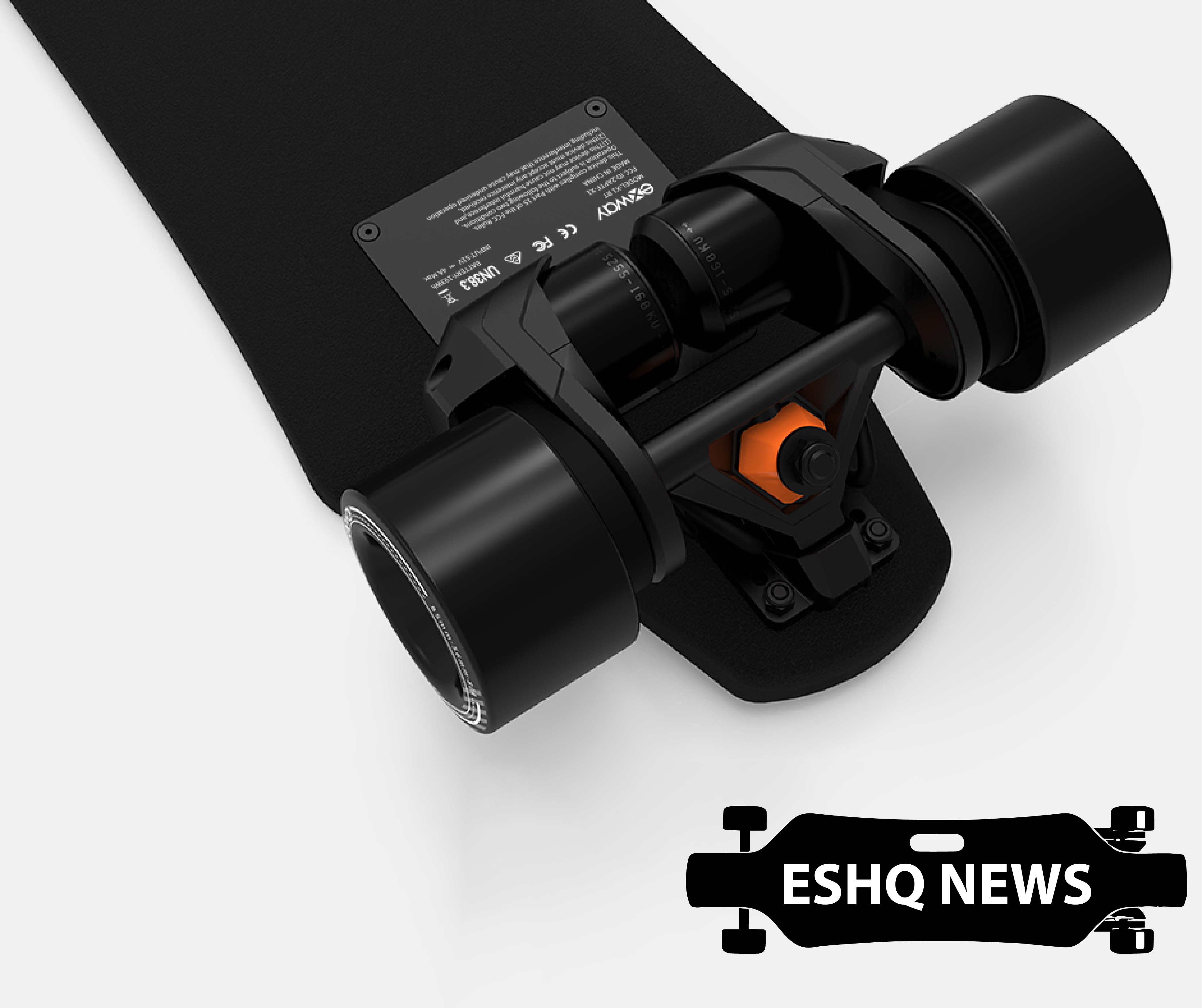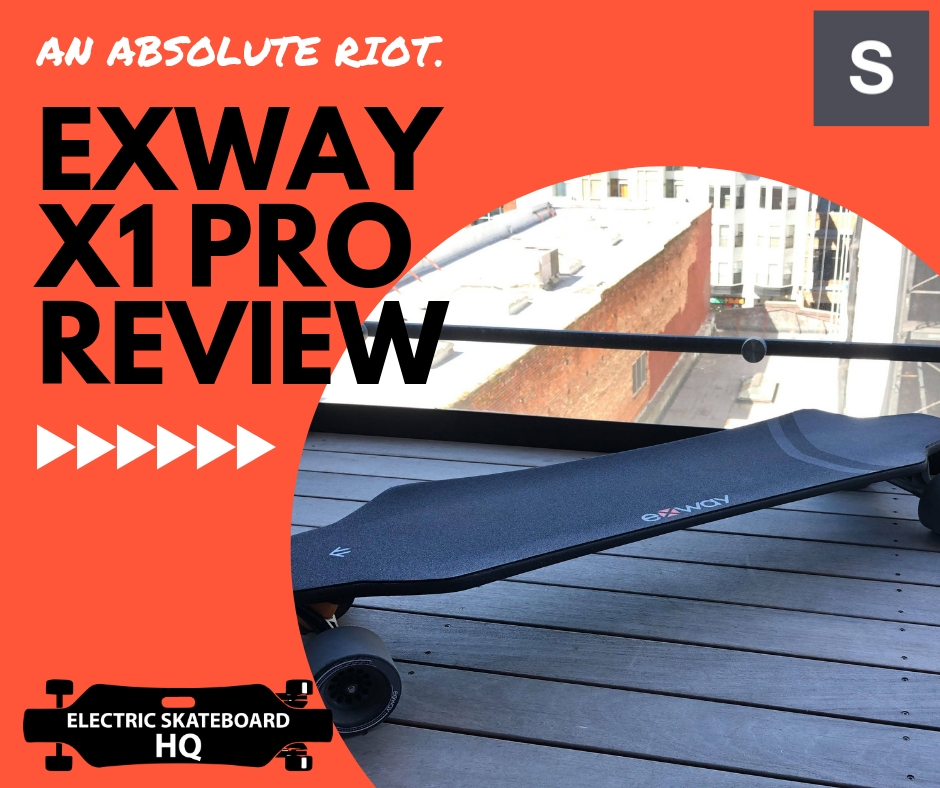You know how sometimes you really like something and you use it a lot, like every day a lot? That’s me and my X1 Pro. I use it every single day for commuting to work, for running errands, for going to eat, for groceries, everything. I love this board. But you know, I always thought there was a little bit something missing. “you know what?” I would think, “This board needs belt drives.”
My wish was answered when the Riot kit for the X1 Pro came out. It’s a very impressive piece of kit. It comes in a nice box with the drivetrain already assembled for forward mount and all the tools and screws you could possibly need packaged very securely. There’s also an instructions manual with clear steps explaining how everything fits together. The kit also comes with new 2nd generation Exway wheels that have improved urethane and profile.
And also these cute stickers

Let’s talk Riot specs
Since my last review, the Riot specs have changed. Here are the new specs:
- Dual 5255 motors with 4235 stators (for reference 5065 motors have 4035 stators)
200KV160KV winding- 1:2.57 gear ratio
35MPH26MPH top speed255-5m-10255-5m-12 belts- Rear mountable for better pothole and curb clearance

When I reviewed Riot last, it was still a prototype and Exway was still trying to figure out a good balance. If they had gone to market with the original motor KV, the Exway would have been the fastest production board on the market. However, Exway decided to lessen the motor KV for more torque, which I appreciate as well. It’s a fine balance act between the two, and I don’t envy manufacturers having to make these decisions and sticking with them forever.
Installation
As soon as I received the kit, I immediately installed it on my X1 Pro. I was excited to have belt drives and full urethane on one of my favorite boards.
The installation was simple and straightforward. Slightly peel back the griptape above the back trucks to expose the four baseplate screws, and unscrew them.

The drivetrain simply comes off. Now simply pop Riot on and use the new slightly longer screws provided with the kit to screw them back in. Don’t forget the rubber riser!
But wait, the remote is telling us something
Don’t forget to change your board settings to Riot mode in the Exway app. I love Exway’s attention to detail.
Oh also, Exway’s 2nd generation wheels come in clear and they’re great. They don’t really yellow at all.
Now that it’s installed,
It’s time to ride!

The first thing I immediately noticed was the increase in torque. Off the line, the X1 Pro Riot is significantly more torquey. Braking is also significantly more torquey as well. Before on hubs, the brakes will stop you. But now, they will seriously stop you. I’m able to come to a full stop on steep SF hills without free mode on. That’s an accomplishment on any board.

The ride quality and handling is also significantly improved as well. I feel like a lot of people don’t realize how much of a difference hubs vs full urethane is. A lot of times I see people online talking about belt versus hubs, and in my opinion one of the main things they miss is handling. Most people might not care, but assuming the same exact bushings setup, truck setup, and urethane durometer, the hub setup will loose out on handling. The reason for this is because with a full urethane wheel, depending on the size, you have at least three or four times the amount of urethane to compress when riding. But on a hub motor, you have that one outer layer of urethane, then you hit the solid hub motor can. This means that you will have less grip (less urethane to deform), lower rebound, (again, less urethane to deform), less road imperfection absorption, etcetera.
Ahem. Please excuse my rant.

This isn’t to say that there aren’t some caveats
The standard configuration that Riot comes in has the motors mounted under the board, otherwise commonly known as forward mounting. There are a couple advantages to this configuration, most notably it’s still generally “stealth” looking if you don’t look closely, and you can still kick your board up by the tail into your hand. However, on the Exway, it sort of hinders access to the charge port. This is not to say it’s not completely unreachable, just slightly more difficult to reach.

There is another configuration supported by Riot, called rear mounting. Basically this means you flip your motor mounts around so that they’re sticking out the back. This is easily done by taking the drive cover, wheel, belt, and wheel pulley off each side, unscrewing the big clamp screw on the side each mount, and turning the mount around until the key sits properly in the keyway in the rear mount position. I must say I’m a fan of Exway’s mount design, especially since it’s for Seismic trucks. I love Seismic trucks.
Anyways, in this rear mounted configuration, port access is no longer a problem. However, now another slight inconvenience arises. You can now no longer easily kick your board up by the tail. To be honest, for me this is a big inconvenience. I use this board for lots of situations where I need to quickly pick it up, and bending down often to pick the board up off the ground gets tiring real quick. I know I’m lazy, but, well, there it is.
Another caveat of the Riot kit is that it’s quite loud. Personally I’m ok with this and like it a bit, but for some people it might be a deal breaker. There is also the issue of belt induced kickpush resistance, however I would say if you tension the belts properly on your kit, you shouldn’t have any big issues. As a general rule, the correct tension should be 3mm of give when you press down on the belt with one finger lightly. There is also a very slight reduction in range in my testing, but i’m talking about near statistically insignificant reductions, so I’m saying this as a warning rather than a true caveat.
All in all,

I think the Riot kit is worth it if you live in a hilly area or if you are a chunkier individual in need of more torque. I also think it’s worth it if you want great ride quality. So what about me? For me, I think I’ll swap back to hubs because bending down every time I want to pick the board up is getting to me. I know I did wish for a proper belt drive for the X1 Pro, but alas, I’m just too lazy.
Click here to check out the Exway X1 Pro Riot (Asia), (USA).

























































